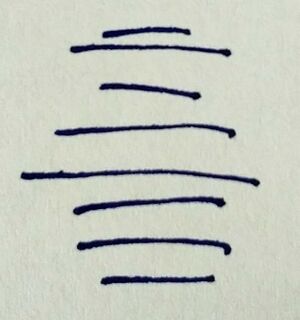Stacked fractions: Difference between revisions
Jump to navigation
Jump to search
No edit summary |
No edit summary |
||
| Line 3: | Line 3: | ||
A fraction written on multiple levels is often ambiguous, especially when handwritten. For example, \(\frac{10}{\frac{2}{5}}\) and \(\frac{\frac{10}{2}}{5}\) result in 25 and 1, respectively. | A fraction written on multiple levels is often ambiguous, especially when handwritten. For example, \(\frac{10}{\frac{2}{5}}\) and \(\frac{\frac{10}{2}}{5}\) result in 25 and 1, respectively. | ||
Things get even worse when you use the letter \(\Xi\): | Things get even worse when you use the letter \(\Xi\) in this convoluted example: | ||
\[ \frac{\Xi}{\bar\Xi} \] | \[ \frac{\Xi}{\bar\Xi} \] | ||
[[File:Xi bar over Xi .jpg|thumb]] | |||
